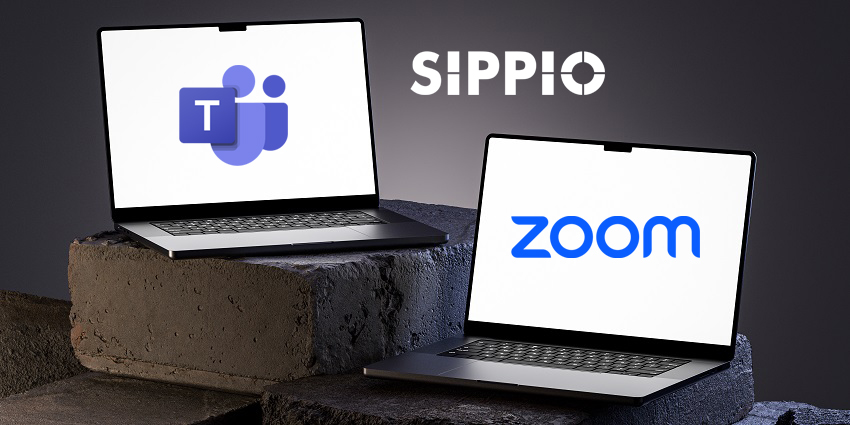In 2025, UC service providers face a critical decision between Microsoft Teams and Zoom, two of the titans in UC and collaboration.
While Teams benefits from deep Office 365 integration, Zoom is erecting a fortress in cost-sensitive markets with its streamlined, user-friendly approach. As businesses increasingly consolidate tech stacks, it’s pivotal that UC service providers align their offerings with market demands. The biggest growth opportunity resides in the SMB/SMC segment, where automation and cloud-based provisioning can significantly reduce operational overhead.
SIPPIO is uniquely positioned to outline each platform’s opportunities and challenges in this article and offer its expertise on how service providers can strategically position themselves for success.
The Opportunity for Service Providers in Choosing Teams or Zoom
The UC market has evolved dramatically since the pandemic, with Zoom rapidly joining Teams as two of its most key players. The enterprise segment is largely saturated at this stage, but the SMB/SMC sector remains an open playing field. Microsoft’s strategy is gradually angling toward this relatively untapped market, but many service providers might be hesitant thanks to the space’s traditional complexities in scaling and provisioning services at a high volume.
Market Shifts and Growth Potential
The SMB/SMC space has arguably long been underserved, with antiquated provisioning methods building obstacles for service providers. However, automation and cloud-native solutions have reset the playing field, making it far easier and more profitable to serve this high-volume market.
Microsoft and Zoom are both neatly positioning themselves strategically to capture this segment, albeit with different perspectives and methodologies.
Microsoft Teams: Strengths and Challenges
Microsoft Teams offers myriad advantages that make it a compelling option for businesses. Its deep integration with Office 365 allows organisations already leveraging Microsoft’s ecosystem to adopt Teams seamlessly.
The platform also includes enterprise-grade security and compliance, making it particularly appealing for regulated industries. Cost-conscious businesses aiming to streamline their technology stack benefit from Teams’ comprehensive feature set within Office 365.
Meanwhile, Operator Connect and Direct Routing allow service providers to integrate Teams with telephony services, thereby extending their market reach.
However, Teams does encompass multiple challenges. Microsoft recently increased the price of Teams Phone by $2 per user and paywalls its flagship Copilot AI service behind a $30 per month fee, making cost a growing concern. SMBs may specifically find the platform complex to adopt and manage, especially those with limited IT resources.
Additionally, SMBs that do not necessarily intend to utilise the rest of Office 365’s app suite may not view Teams as a convincing alternative to a more lightweight option like Zoom.
Zoom: Strengths and Challenges
Zoom has carved a niche in the market by presenting lower costs and a more accessible pricing model. Unlike Microsoft, which added fees for AI features, Zoom provides AI Companion at no additional charge, making it an even more cost-effective choice. The platform has been renowned for its simplicity and ease of use since the pandemic, an elegant user experience it has maintained since it exploded into the mainstream in 2020, making it particularly attractive for SMBs that need minimal IT support.
Furthermore, Zoom is expanding its product ecosystem with offerings like Zoom Mail, Calendar, and Docs, elevating itself as a robust, all-in-one productivity suite. Its powerful appeal to smaller, budget-conscious businesses allows it to compete effectively with Microsoft in this segment.
Despite its strengths, Zoom faces challenges in the enterprise space, where Microsoft’s dominance with Office 365 makes competition problematic. Zoom is still perceived by many as a video conferencing tool first and foremost rather than as the comprehensive UCaaS solution it has evolved into, which might impede its adoption among businesses desiring an all-in-one comms platform.
Additionally, while Zoom Phone continues to grow, it does not yet offer the same extent of telephony integration as Microsoft Teams, particularly in Operator Connect and Direct Routing.
Choosing the Right Platform: A Strategic Approach
For UC service providers, the best strategy isn’t restricted to an either-or decision. Preserving flexibility to support both Teams and Zoom empowers providers to maximise their addressable market.
Organisations that are thoroughly embedded in the Microsoft ecosystem will favour Teams, while SMBs and cost-sensitive clients may opt for Zoom due to its simplicity and affordability. Irrespective of the platform, automation in provisioning and customer self-service is critical for skirting exorbitant overhead and reinforcing scalability.
By remaining platform-agnostic, service providers can support both Teams and Zoom, increasing their potential customer base and revenue streams.
How SIPPIO Supports Service Providers To Grasp This Opportunity
Service providers need scalable, automated solutions to successfully serve the SMB/SMC market. SIPPIO provides a significant advantage in this space. Running on Microsoft Azure, SIPPIO’s cloud-based infrastructure eliminates the necessity for physical hardware, minimising costs and enhancing margins, even on single-seat activations.
Fully automated provisioning allows business customers to sign up, pay, and activate services without the hurdle of manual intervention, meaning service providers can handle high-volume demand without increasing labour costs.
SIPPIO’s flexible API-first model integrates seamlessly with existing infrastructure so that providers can sustain their investments in SBCs while leveraging SIPPIO’s automation capabilities. Backed by the SIPPIO Store, providers can offer a branded marketplace where customers can purchase UCaaS solutions alongside other services like IP phones and consulting.
Crucially, SIPPIO’s low-risk commercial model demands no upfront capital investment, marrying its success to that of its service provider partners so that mutual growth is the north star.
By collaborating with SIPPIO, UC service providers can effortlessly support both Microsoft Teams and Zoom, scaling their operations efficiently and profitably without infrastructure obstacles.
Conclusion
For UC service providers, the decision between Microsoft Teams and Zoom is less about competition and more about alignment with customer needs. Teams is still dominant in the enterprise space, while Zoom is poised to appeal to SMB/SMC businesses with cost efficiencies and ease of use. The primary key to success is adopting an automation-first approach that allows providers to scale profitably.
By leveraging SIPPIO, service providers can seamlessly support both platforms, supercharging their market reach and revenue potential.
- SIPPIO, Akixi Partner On Advanced Call Analytics For Microsoft Teams
- SIPPIO, Mutare Partner To Bolster Voice Traffic Security
__________________________________________________________________________________________________________________________________________________________________________________
Transform Higher Ed Communication with Microsoft Teams & SIPPIO!
Higher education is evolving—is your institution keeping up?
Microsoft Teams, powered by SIPPIO, is revolutionizing how universities cut costs, simplify IT, and enhance digital communication for students and faculty alike. From reducing phone system expenses to improving mobility and collaboration, Teams provides a modern, seamless communication experience tailored for today’s academic world.
- Lower costs by replacing legacy systems
- Boost mobility with seamless, secure calling
- Unify voice, messaging, and collaboration in one platform
Join leading universities like Roseman University in embracing a future-ready communication strategy. Discover how SIPPIO can streamline your institution’s digital transformation today!







